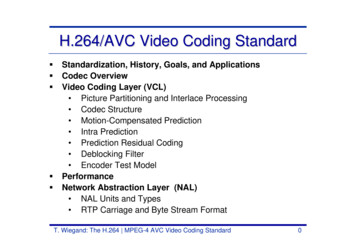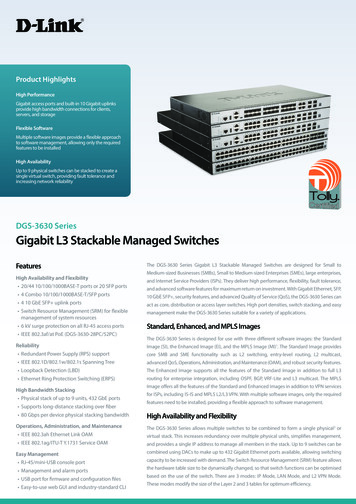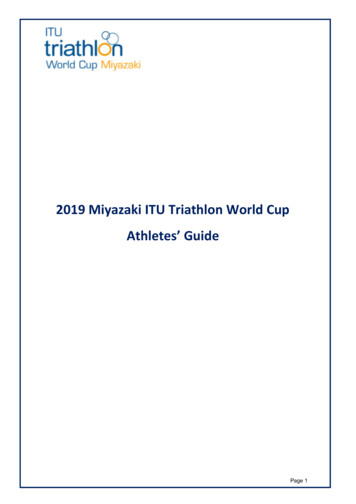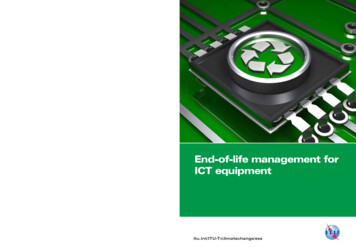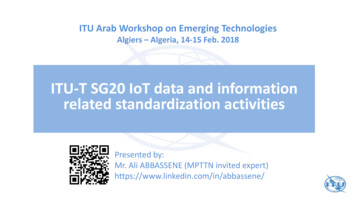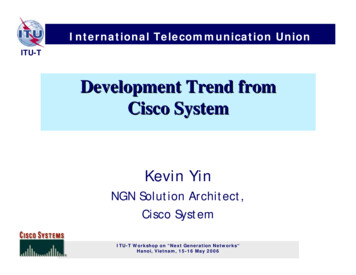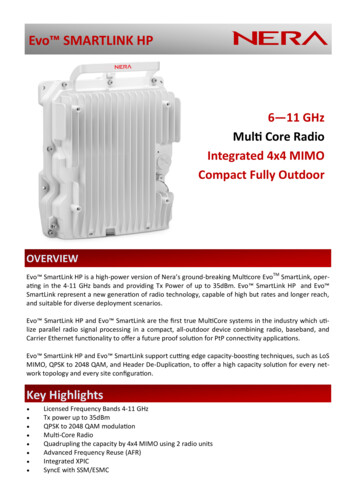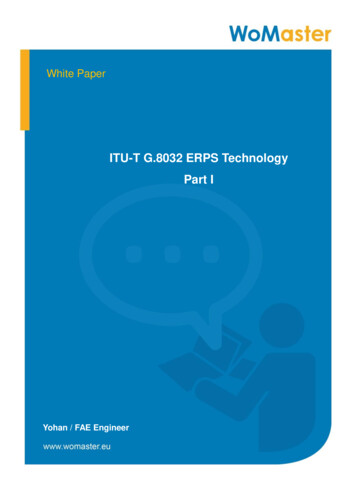
Transcription
White PaperITU-T G.8032 ERPS TechnologyPart ITechnologyYohan / FAE Engineer
ERPS (G.8032) V2 Technology White PaperHave a solid network with Ring on it.Ethernet Ring Protection Switching (ERPS) is a protocol defined by the InternationalTelecommunication Union - Telecommunication Standardization Sector (ITU-T) to prevent loops atLayer 2. With the standard number is ITU-T G.8032, and ERPS is also called G.8032. Generally,redundant links are used on a network to provide link backup and enhance network reliability. The useof redundant links, however, may produce loops, causing broadcast storms and rendering the MACaddress table unstable. These can affect the network, where the communication quality is not goodenough, and communication services might be interrupted.The Spanning Tree Protocol (STP), Rapid Spanning Tree Protocol (RSTP), and Multiple Spanning TreeProtocol (MSTP) are often used to prevent loops. STP meets network reliability requirements butprovides slow convergence. Although RSTP and MSTP make enhancements, their convergence is stillat the second level.Compared with STP, RSTP and MSTP, ERPS has the following advantages: Fast network convergenceERPS provides advantages of traditional ring network technologies such as STP/RSTP/MSTP andoptimizes detection mechanism to provide faster convergence. For example, the ERPS-enabled switchprovides 50-ms convergence for broadcast packets. Good compatibilityERPS is a standard Layer 2 loop prevention protocol issued by the ITU-T. It can be used forcommunication between Womaster and non-Womaster devices on a ring network.There were some basic concepts that support ERPS Ring. Ring Protection Link (RPL) – Link designated by mechanism that is blocked during Idle stateto prevent loop on Bridged ring. RPL Owner node – Node connected to RPL that blocks traffic on RPL during Idle state andunblocks during Protection state. RPL Neighbor node – Node connected to RPL that blocks traffic on RPL during Idle state andunblocks during Protection state (v2). Link Monitoring – Links of ring are monitored using standard ETH CC OAM messages (CFM) Signal Fail (SF) – Signal Fail is declared when signal fail condition is detected. No Request (NR) – No Request is declared when there are no outstanding conditions (e.g., SF,etc.) on the node. Ring APS (R-APS) Messages – Protocol messages defined in Y.1731 and G.8032. Automatic Protection Switching (APS) Channel - Ring-wide VLAN used exclusively fortransmission of OAM messages including R-APS messages.
G.8032 or ERPS use different timers to avoid race conditions and unnecessary switching operations. Delay Timers –RPL Owner used this to verify that the network has stabilized before blockingthe RPL.–After SF (Signal Fail) condition – Wait-to-Restore (WTR) timer used to verify that SFis not intermittent.–After Force Switch/Manual Switch command – Wait-to-Block (WTB) timer used toverify that no background condition exists (v2).– WTB timer may be shorter than the WTR timer.Guard Timer – Used by all nodes when the state is change, it also blocks latent outdatedmessages from causing unnecessary state changes. Hold-off Timers – Used by underlying ETH layer to filter out intermittent link faults.–Faults will only be reported to the ring protection mechanism if this timer expires.For better understanding about ERPS, the understanding about what is loop is important. A loop is aconfiguration where a frame travels around a network without any ending it just going back to whereit started. The figure below is an example of a simple loop.We can say that a loop avoiding protocol has not been used on switches we could see where a framecould be sent from one switch to the next. It would keep going around and eating up bandwidth. Evenmore, the frames passing around the loop will cause trouble with the MAC address tables, where anetwork will not allow packets to pass through it.After we understand about loops, we also understand that loops are not good things for our networkbut we would like to have the path redundancy that a loop provides. ERPS is one way of accomplishingthis. An Ethernet ring consists of switches that form a closed physical loop. Each ring switch isconnected to two adjacent Ethernet ring switches. This is the simple explanation about loop that weneed to avoid earlier, but since the network using ERPS on it the network can work excellent.
ERPS PrinciplesNormal State1. All nodes in a physical topology are connected to as rings.2. ERPS blocks RPLs to prohibit formation of loops. In the figure above, the link between Node1 andNode4 is an RPL.3. ERPS detects failures on each link between adjacent nodes.Link Failure1. The nodes adjacent to a failed link block the failed link and send the R-APS(SF) message to notifyother nodes in the ring of the link failure. In the figure above, the link between Node2 and Node3 fails.2. After the hold-off timer expires, Node2 and Node3 block the failed link and send the R-APS(SF)message to other nodes in the ring.3. The R-APS(SF) message triggers the RPL owner node to unblock the RPL port. All nodes update theirMAC address entries and ARP/ND entries and the ring enters the protection state.
Failure Recovery1. When a failed link is restored, nodes adjacent to the link are still blocked and they send theR-APS(NR) message, indicating that no local failure exists.2. After the guard timer expires and the RPL owner node receives the first R-APS(NR) message, theRPL owner node starts the WTR timer.3. After the WTR timer expires, the RPL owner node blocks the RPL and sends the R-APS(NR, RB)message. And the ring state is pending, while waiting for the WTR timer expires.4. After receiving the R-APS(NR, RB) message, other nodes update their MAC address entries andARP/ND entries, and the nodes that send the R-APS(NR) message stop periodic transmission of themessage and unblock the blocked ports. The ring network is restored to the normal state which is idlestate.Benefits of adapting G.8032 v2 Ethernet Ring Protection Switching With G.8032 v.2 ERPS is tending to replace proprietary ring redundancy and standardEthernet Ring Switching, as it provides stable protection of the entire Ethernet Ring from anyloops. With the growth of the network scale, the calculation and response time in case of loopformation increases and could be from 2 120 sec to 5 minutes, and this is completelyunacceptable in critical networks where the uninterrupted communication is required. Loopsfatally affect network operation and service availability, thus, deploying network equipmentwith supported ITU-T G.8032 v2 ERPS with less than 50ms recovery time will significantlyincrease network reliability. G.8032 v1 standard supported single ring topology, whilst G.8032 version 2 additionallyprovides recovery switching for Ethernet traffic in Multiple Ring of conjoined Ethernet Ringsby one or more interconnections which saves deployment costs by providing wide-area
multipoint connectivity with reduced number of links. Important to note, deploying switches supporting G.8032 v2 ERPS provides economicaland highly resilient Ethernet infrastructure, as they can interoperate with third partyswitches and still guarantee fast network recovery time without any data loss.ERPS ring is one of technology that ideal for every application, this technology currently has providedthe best option. If you still want to know more, please contact us at help@womaster.euAbout WomasterWoMaster Group is an international group based in Europe, with over 20 years of industrialmarket experience. We provide rugged products with customer oriented support for criticalapplications such as railway, power and utility, waste water, intelligent transportation and IPsurveillance.The WoMaster brand’s name distinguishes our target markets as well as symbolizes the naturesources which enforced us to become Master brand for Industrial Data CommunicationMarket.
ERPS (G.8032) V2 Technology White Paper Have a solid network with Ring on it. Ethernet Ring Protection Switching (ERPS) is a protocol defined by the International Telecommunication Union - Telecommunication Standardization Sector (ITU-T) to prevent loops at Layer 2. With the standard number is ITU-T G.8032, and ERPS is also called G.8032. .
